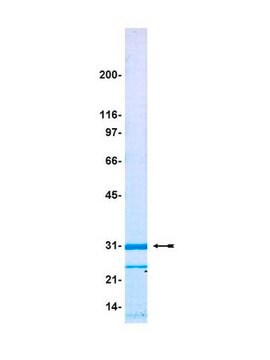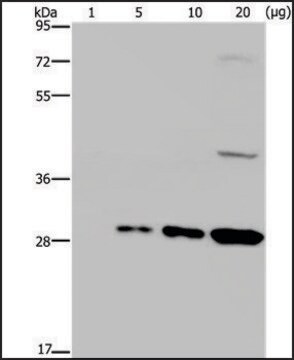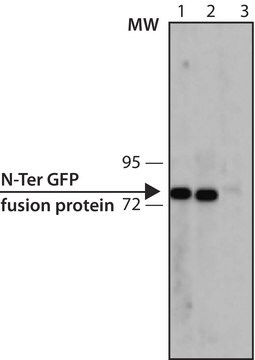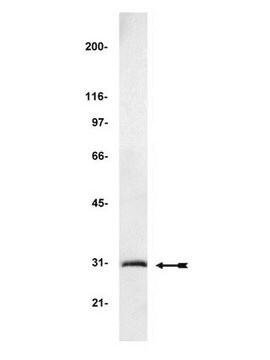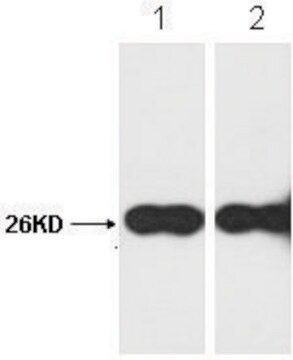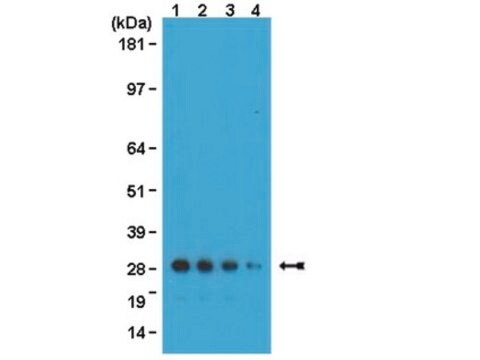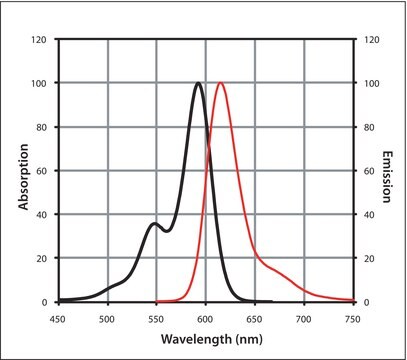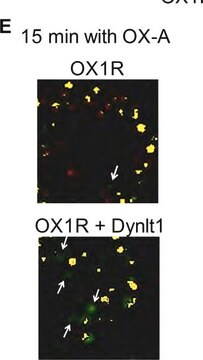おすすめの製品
由来生物
mouse
品質水準
結合体
unconjugated
抗体製品の状態
purified from hybridoma cell culture
抗体製品タイプ
primary antibodies
クローン
GSN149, monoclonal
フォーム
buffered aqueous solution
包装
antibody small pack of 25 μL
テクニック
indirect ELISA: suitable
western blot: 1-2 μg/mL using extracts of cells expressing GFP fusion proteins
アイソタイプ
IgG1
輸送温度
dry ice
保管温度
−20°C
ターゲットの翻訳後修飾
unmodified
詳細
GFP融合タンパク質と特異的に反応します。
Monoclonal Anti-Green Fluorescent Protein (GFP) (mouse IgG1 isotype) is derived from the hybridoma GSN149 produced by the fusion of mouse myeloma cells and splenocytes from BALB/c mice immunized with a synthetic peptide of the Green fluorescent protein from jellyfish Aequorea victoria. GFP is a 27 kDa protein (238 amino acids) that can produce a strong green fluorescence without the need for a substrate. It absorbs light maximally at 395 nm and emits a bright green fluorescence with a peak at 509 nm. The GFP chromophore is formed through cyclization and oxidation of an internal tripeptide motif (Ser65, Gly69 and Tyr66).
アプリケーション
Applications in which this antibody has been used successfully, and the associated peer-reviewed papers, are given below.
Monoclonal Anti-Green Fluorescent Protein (GFP) antibody produced in mouse was used in surface plasmon resonance (SPR) gold chip analysis to study the cysteine- and domain-mediated immobilization of enhanced GFP model protein.
生物化学的/生理学的作用
GFP is implicated in protein detection and localization in living cells, as well as gene expression monitoring in prokaryotes and eukaryotes. It detects protein-protein interactions in living cells.
Green fluorescent protein, produced in the jellyfish, Aequorea victoria, acts as secondary fluorescent protein in an energy transfer reaction to produce green light. It ability to produce a highly visible, internal fluorophore is widely applicable as marker for gene expression and to produce chimeric proteins to understand protein biochemistry.
物理的形状
15 mMアジ化ナトリウム含有のpH 7.4の0.01 Mリン酸緩衝食塩水溶液.
免責事項
Unless otherwise stated in our catalog or other company documentation accompanying the product(s), our products are intended for research use only and are not to be used for any other purpose, which includes but is not limited to, unauthorized commercial uses, in vitro diagnostic uses, ex vivo or in vivo therapeutic uses or any type of consumption or application to humans or animals.
適切な製品が見つかりませんか。
製品選択ツール.をお試しください
保管分類コード
12 - Non Combustible Liquids
WGK
nwg
引火点(°F)
Not applicable
引火点(℃)
Not applicable
個人用保護具 (PPE)
Eyeshields, Gloves, multi-purpose combination respirator cartridge (US)
適用法令
試験研究用途を考慮した関連法令を主に挙げております。化学物質以外については、一部の情報のみ提供しています。 製品を安全かつ合法的に使用することは、使用者の義務です。最新情報により修正される場合があります。WEBの反映には時間を要することがあるため、適宜SDSをご参照ください。
Jan Code
G1546-200UL:
G1546-BULK:
G1546-25UL:
G1546-VAR:
G1546-100UL:
この製品を見ている人はこちらもチェック
GFP: Lighting up life.
Martin Chalfie
Proceedings of the National Academy of Sciences of the United States of America, 106(25), 10073-10080 (2009-06-26)
Kyoungsook Park et al.
The Analyst, 136(12), 2506-2511 (2011-04-27)
Here we report an effective method for protein immobilization on a surface plasmon resonance (SPR) gold chip, describing the combination of cysteine- and oligomerization domain-mediated immobilization of enhanced green fluorescent protein (EGFP) as a model protein for the purpose of
The dynamic microbe: green fluorescent protein brings bacteria to light
Southward CM and Surette MG
Molecular Microbiology, 45(5), 1191-1196 (2002)
Visual screening of microspore-derived transgenic barley (Hordeum vulgare L.) with green-fluorescent protein
Carlson AR, et al.
Plant Cell Reports, 20(4), 331-337 (2001)
Annouck Luyten et al.
Molecular biology of the cell, 19(4), 1594-1604 (2008-02-08)
Wnt signaling pathways are essential for embryonic patterning, and they are disturbed in a wide spectrum of diseases, including cancer. An unresolved question is how the different Wnt pathways are supported and regulated. We previously established that the postsynaptic density
ライフサイエンス、有機合成、材料科学、クロマトグラフィー、分析など、あらゆる分野の研究に経験のあるメンバーがおります。.
製品に関するお問い合わせはこちら(テクニカルサービス)

